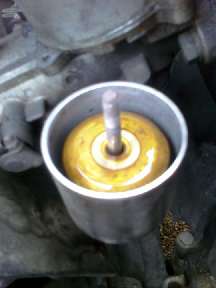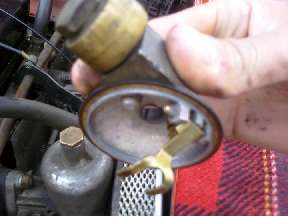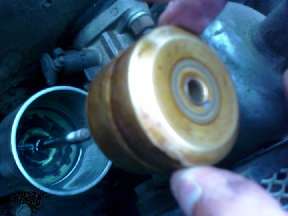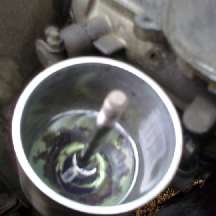The MGA With An Attitude
FUEL OVERFLOW from your SU Carburetors - CB-116
On Apr 13, 2010, Juan Gil Gutierrez in Barcelone, Spain, wrote:
"The carbs started leaking gently. The front carb leaks through the vent pipe but the rear one leaks from the bottom side. They are pouring over the exhaust system and yes, I've just read your suggestion about making those vent pipes longer. Apart from extending the pipes, any cue about why they both could start pouring at the same time but from different places.
"First I've opened the float cover, in the inside youŽll find this, the float valve. By pressing it sightly you'll notice a slight "click" when it closes the fuel admission into the chamber. I blew some air and checked that nothing obstructs the correct valve function.


"Then I checked the float, that copper piece floating in the fuel chamber. It was rather dirty and tried to clean it a little with gasoline (available in the chamber) and an old rag. I've being told that sometimes this float got drilled somehow and when they get filled with gasoline they sink, so the float valve never could get pressed by them.
"When I cleaned the float I found what looks dirt in the bottom of the chamber, that's something I should fix soon but I guess I will need to remove the whole carb. Am I right? Another detailed pic about that dirt sediment in the fuel chamber".


Okay, here's the skinny. If the float valve clicks, that means it sticks. The valve plunger should rise with a gentle touch and should drop by gravity alone. Pull the cross shaft to remove the lever, then remove the valve plunger for cleaning. If it still sticks, see how far you can throw it, and install a new one.
If the brass float develops a pin hole or crack, it can fill with fuel and sink. Just pick up the the two floats, compare the weights, and shake them. If one is heavier it will slosh when shaken because of fuel inside. In that case, put the part in a pan of water and heat it (gently and slowly) on an electric stove (not over an open gas flame). Motor fuel will boil at lower temperature than water, so before the water boils the float will be bubbling as boiled off fuel vapor will escape from the crack or hole. This way you can identify the point of leakage, and if it might be a void in a solder joint or a crack in the brass. When it stops bubbling, and the water starts to boil, the fuel is all boiled out of the float. Remove the float from the water immediately. If you allow the water to cool without removing the part, the float will suck water inside, and that is more difficult to remove than the gasoline.
A bad solder joint can be soldered to seal it up. A crack in a flat or cylindrical surface may be patched with an overlay of thin brass shim soldered in place. A crack on a corner or spherical surface is much more difficult to patch. If you can't patch it, a new brass float is under $20-USD.
If you are a bit of a contortionist you may be able to remove the banjo bolt or nut on the bottom to dismount the float bowl. You need to do this anyway to replace the rubber sealing grommets on the banjo bolt. While the float bowl is off it is easy to clean. Note that the large washer below the lower rubber grommet is cup shape (on the 1500 type carbs only), and the concave side must be up. When the rubber grommets are new and in good condition the mounting is quite firm, but the chamber can still be moved a little with some force. The rubber grommets deteriorate when exposed to "modern" gasoline. Moss Motors USA now sells grommets made from Viton that are much more fuel resistant.
That small amount of fine grained dirt (thin mud) in the bottom of the float chamber should not bother anything, although it is a hint at some dirt in the fuel tank. See the relatively large size of the port (hole) leading through the bottom arm to the banjo bolt. Once fuel is through the banjo bolt it goes through fairly large holes in the side of the main jet, then out the top of the jet. The tapered needle is always on the move up/down as the engine runs, so the jet will never get clogged. The problem with fuel flow, clog or overflow, is either at the float valve or with the thimble size screen at the input port in the float cover. Otherwise overflow may be caused by excess fuel pressure (greater than 4.5 PSI).
Clean the float bowl once, and see how long it stays clean. If you have a sintered brass or paper filter anywhere in line between the fuel tank and carbs, the float chamber should stay clean. If the filter gets clogged, install a new one maybe once a year. If it clogs up more often you need to clean or replace the dirty (usually rusty) fuel tank.
My MGA ran for decades with only the wire mesh screens in the fuel pump and carb inlets, has never had any dirt problems. There was never anything in the screens to clean out, just a touch of light dirt in the bottom of the float chambers, exactly like yours. When I installed an aftermarket electronic fuel pump the instructions called for a filter before the pump. This filter is a tiny little sintered brass affair no larger than a wine cork, and it goes 100,000 miles without clogging up. That means there is no dirt in my fuel tank, with particles so large that it cannot pass through the filter. The trick is to start clean, then keep driving it to keep flushing fuel through the system, and the fuel flow will serve as the solvent to keep the entire system clean. Over a period of 12 years and 130,000 miles it even dissolved and gradually washed away a coating of slushing compound sealer from inside of the tank. This was probably aided by 10% alcohol content in the fuel beginning in the late 1980's, and a variety of other noxious chemical additives. This never clogged anything up, so the tank inside has been pristinely clean bare metal for the past 10 years and another 110,000 miles.
|